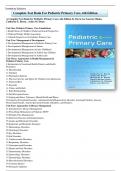Created by Solutions
Complete Test Bank For Pediatric Primary Care, 6th Edition
A Complete Test Bank for Pediatric Primary Care, 6th Edition by Dawn Lee Garzon Maaks,
Catherine E. Burns , Ardys M. Dunn
Unit One: Pediatric Primary Care Foundations
1. Health Status of Children: Global and Local Perspectives
2. Child and Family Health Assessment
3. Cultural Perspectives for Pediatric Primary Care
Unit Two: Management of Development
4.Developmental Management in Pediatric Primary Care
5.Developmental Management of Infants
6.Developmental Management in Early Childhood
7.Developmental Management of School-Age Children
8.Developmental Management of Adolescents
Unit Three: Approaches to Health Management in
Pediatric Primary Care
9. Introduction to Functional Health Patterns and Health
Promotion
10. Breastfeeding
11.Nutrition
12.Elimination Patterns
13. Physical Activity and Sports for Children and Adolescents
14. Sleep and Rest
15.Sexuality
16. Values and Beliefs
17. Role Relationships
18.Self-Perception Issues
19.Coping and Stress Tolerance: Mental Health and Illness
20.Cognitive-Perceptual Disorders: Attention-Deficit/Hyperactivity Disorder, Learning Problems, Sensory
Processing Disorder, Autism Spectrum Disorder, Blindness, and Deafness
Unit Four: Approaches to Disease Management
21.Introduction to Disease Management
22.Prescribing Medications in Pediatrics NEW!
23.Pediatric Pain Management
24.Infectious Diseases and Immunizations
25.Atopic and Rheumatic Disorders
26.Endocrine and Metabolic Disorders
27.Hematologic Disorders
28.Neurologic Disorders
29.Eye Disorders
30.Ear Disorders
31.Cardiovascular Disorders
32.Respiratory Disorders
33.Gastrointestinal Disorders
34.Dental and Oral Disorders
35.Genitourinary Disorders
36.Gynecologic Disorders
37.Dermatologic Disorders
38.Musculoskeletal Disorders
39.Common Injuries
40.Perinatal Conditions
,Created by Solutions
41.Genetic Disorders
42.Environmental Health Issues
43.Complementary Medicine
44. Strategies for Managing a Pediatric Health Care Practice
45. **:Considerationofethicalissues,societalimplications,andapplicationsofbiologicalknowledgeinareassuchasmedicine,biotechnology,conservation,andenvironmentalsustainabil
ity.**HistoricalPerspectives**:Overviewofsignificantmilestonesandcontributionsinthedevelopmentofbiologyasascientificdiscipline,includingkeyfigures,discoveries,andadvanc
ementsinbiologicaltheories.**ToolsandTechniques**:Introductiontolaboratorytechniques,instruments,andmethodologiesusedinbiologicalresearch,suchasmicroscopy,DNAse
quencing,biochemicalanalysis,andcomputationalbiology.**CurrentChallengesandFrontiers**:Discussiononcontemporarychallengesfacingbiology,suchasemerginginfectious
diseases,climatechangeimpacts,biodiversityloss,andtheapplicationofbiotechnologicalinnovations.**SummaryandKeyConcepts**:Thechapterconcludeswithasummaryofkeyc
onceptsdiscussed,reinforcingthefoundationalprinciplesofbiologyandpreparingstudentsforfurtherexplorationinsubsequentchapters.Chapter1of"EssentialsofBiology"aimstopro
videstudentswithacomprehensiveintroductiontothescientificstudyoflife,emphasizingitsbreadth,significance,andrelevanceinunderstandingthenaturalworldandaddressingglob
alchallenges.Itsetsthestagefordeeperexplorationintobiologicalconceptsandprinciplescoveredthroughoutthetextbook .Ifyouhavespecificquestionsaboutanyofthesetopicsorwouldlikemor
edetailedinformationonaparticularaspectofChapter1,feelfreetoask!Chapter2Chapter2of"EssentialsofBiology"bySylviaMaderandMichaelWindelspecht,titled"TheChemicalBasisofLife,"typicallydelvesintot
hefoundationalprinciplesofchemistryastheyrelatetobiologicalsystems.Here‟sanoverviewofwhatyoumightfindinthischapter:**IntroductiontoBiochemistry**:Definitionofbiochemistryasthebranchofchemistryc
oncernedwiththechemicalprocessesandsubstancesthatoccurwithinlivingorganisms.**ElementsandAtoms**:Explanationofbasicchemicalelementsessentialtolife,theiratomicstructure(protons,neutrons,ele
ctrons),andhowatomscombinetoformmolecules.**ChemicalBonds**:Discussionondifferenttypesofchemicalbonds(covalent,ionic,hydrogenbonds)andtheirroleinholdingatomstogetherinmoleculesandcom
pounds.**PropertiesofWater**:Explorationofwaterasapolarmolecule,itsuniqueproperties(highcohesion,adhesion,surfacetension,highspecificheatcapacity),anditsimportanceinbiologicalsystems.**Acids,B
ases,andpH**:Definitionofacidsandbases,theirroleinchemicalreactions,andtheconceptofpHasameasureofhydrogenionconcentration.ImportanceofpHregulationinbiologicalprocesses.**OrganicMolecules*
*:Introductiontoorganicmoleculesessentialforlife,includingcarbohydrates,lipids,proteins,andnucleicacids.Structure,function,andbiologicalsignificanceofeachgroupofmolecules.**Carbohydrates**:Structur
eofcarbohydrates(monosaccharides,disaccharides,polysaccharides),theirrolesasenergysourcesandstructuralcomponentsincells.**Lipids**:Classificationoflipids(fats,phospholipids,steroids),theirstructur
e,functions(energystorage,cellmembranes),androlesinbiologicalprocesses.**Proteins**:Structureofproteins(aminoacids,primary,secondary,tertiary,andquaternarystructure),functions(enzymes,structural
proteins,antibodies),andproteinsynthesis.**NucleicAcids**:Structureandfunctionofnucleicacids(DNAandRNA),includingnucleotidestructure,DNAreplication,transcription,andtranslation.**EnzymesandCa
talysis**:Roleofenzymesasbiologicalcatalysts,enzyme-
substrateinteractions,enzymespecificity,factorsinfluencingenzymeactivity,andregulationofenzymefunction.**EnergyandMetabolism**:Overviewofenergytransformationsinbiologicalsystems,
1. Health Status of Children: Global and Local Perspectives
Questions
1. A child who has attention-deficit/hyperactivity disorder (ADHD) has difficulty
stopping activities to begin other activities at school. The primary care pediatric nurse
practitioner understands that this is due to difficulty with the self-regulation component of
A. emotional control.
B. flexibility. Correct
C. inhibition.
D. problem-solving.
2. The primary care pediatric nurse practitioner cares for a preschool-age child
who was exposed to drugs prenatally. The child bites other children and has tantrums when
asked to stop but is able to state later why this behavior is wrong. This child most likely has a
disorder of
A. executive function. Correct
B. information processing.
C. sensory processing.
D. social cognition.
3. The primary care pediatric nurse practitioner uses the Neurodevelopmental Learning Framework to
assess cognition and learning in an adolescent. When evaluating social cognition, the nurse
practitioner will ask the adolescent
A. about friends and activities at school. Correct
,Created by Solutions
B. if balancing sports and homework is difficult.
C. to interpret material from a pie chart.
D. to restate the content of something just read.
4. The primary care pediatric nurse practitioner is evaluating a school-age child who has been diagnosed
with ADHD. Which plan will the nurse practitioner recommend asking the child‟s school about to help
with academic performance?
A. 504 Correct
B. FAPE
C. IDEA
D. IEP
**:Considerationofethicalissues,societalimplications,andapplicationsofbiologicalknowledgeinareassuchasmedicine,biotechnology,conservation,andenvi
ronmentalsustainability.**HistoricalPerspectives**:Overviewofsignificantmilestonesandcontributionsinthedevelopmentofbiologyasascientificdiscipline,inc
ludingkeyfigures,discoveries,andadvancementsinbiologicaltheories.**ToolsandTechniques**:Introductiontolaboratorytechniques,instruments,andmetho
dologiesusedinbiologicalresearch,suchasmicroscopy,DNAsequencing,biochemicalanalysis,andcomputationalbiology.**CurrentChallengesandFrontiers*
*:Discussiononcontemporarychallengesfacingbiology,suchasemerginginfectiousdiseases,climatechangeimpacts,biodiversityloss,andtheapplicationofbi
otechnologicalinnovations.**SummaryandKeyConcepts**:Thechapterconcludeswithasummaryofkeyconceptsdiscussed,reinforcingthefoundationalprinci
plesofbiologyandpreparingstudentsforfurtherexplorationinsubsequentchapters.Chapter1of"EssentialsofBiology"aimstoprovidestudentswithacomprehens
iveintroductiontothescientificstudyoflife,emphasizingitsbreadth,significance,andrelevanceinunderstandingthenaturalworldandaddressingglobalchalleng
es.Itsetsthestagefordeeperexplorationintobiologicalconceptsandprinciplescoveredthroughoutthetextbook .Ifyouhavespecificquestionsaboutanyofthesetopicsorw
ouldlikemoredetailedinformationonaparticularaspectofChapter1,feelfreetoask!Chapter2Chapter2of"EssentialsofBiology"bySylviaMaderandMichaelWindelspecht,titled"TheChem
icalBasisofLife,"typicallydelvesintothefoundationalprinciplesofchemistryastheyrelatetobiologicalsystems.Here‟sanoverviewofwhatyoumightfindinthischapter:**IntroductiontoBioch
emistry**:Definitionofbiochemistryasthebranchofchemistryconcernedwiththechemicalprocessesandsubstancesthatoccurwithinlivingorganisms.**ElementsandAtoms**:Explanatio
nofbasicchemicalelementsessentialtolife,theiratomicstructure(protons,neutrons,electrons),andhowatomscombinetoformmolecules.**ChemicalBonds**:Discussionondifferenttype
sofchemicalbonds(covalent,ionic,hydrogenbonds)andtheirroleinholdingatomstogetherinmoleculesandcompounds.**PropertiesofWater**:Explorationofwaterasapolarmolecule,its
uniqueproperties(highcohesion,adhesion,surfacetension,highspecificheatcapacity),anditsimportanceinbiologicalsystems.**Acids,Bases,andpH**:Definitionofacidsandbases,their
roleinchemicalreactions,andtheconceptofpHasameasureofhydrogenionconcentration.ImportanceofpHregulationinbiologicalprocesses.**OrganicMolecules**:Introductiontoorganic
moleculesessentialforlife,includingcarbohydrates,lipids,proteins,andnucleicacids.Structure,function,andbiologicalsignificanceofeachgroupofmolecules.**Carbohydrates**:Structur
eofcarbohydrates(monosaccharides,disaccharides,polysaccharides),theirrolesasenergysourcesandstructuralcomponentsincells.**Lipids**:Classificationoflipids(fats,phospholipid
s,steroids),theirstructure,functions(energystorage,cellmembranes),androlesinbiologicalprocesses.**Proteins**:Structureofproteins(aminoacids,primary,secondary,tertiary,andqu
aternarystructure),functions(enzymes,structuralproteins,antibodies),andproteinsynthesis.**NucleicAcids**:Structureandfunctionofnucleicacids(DNAandRNA),includingnucleotide
structure,DNAreplication,transcription,andtranslation.**EnzymesandCatalysis**:Roleofenzymesasbiologicalcatalysts,enzyme-
substrateinteractions,enzymespecificity,factorsinfluencingenzymeactivity,andregulationofenzymefunction.**EnergyandMetabolism**:Overviewofenergytransformationsinbiologic
alsystems,
5. The parent of a child diagnosed with ADHD tells the primary care pediatric nurse practitioner
that the child gets overwhelmed by homework assignments, doesn‟t seem to know which ones
to do first, and then doesn‟t do any assignments. The nurse practitioner
tells the parent that this represents impairment in which executive function?
A. Activation Correct
B. Effort
C. Emotion
D. Focus
6. The primary care pediatric nurse practitioner is considering medication
options for a school-age child recently diagnosed with ADHD who has a primarily hyperactive
presentation. Which medication will the nurse practitioner select initially?
A. Low-dose stimulant
B. Moderate-dose stimulant Correct
C. Low-dose non-stimulant
D. Moderate-dose non-stimulant
7. The parent of a 4-year-old child reports that the child gets upset when the
hall light is left on at night and won‟t leave the house unless both shoes are tied equally tight. The
, Created by Solutions
primary care pediatric nurse practitioner recognizes that this child likely has which type of
sensory processing disorder?
A. Dyspraxia
B. Over-responder Correct
C. Sensory seeker
D. Under-responder
**:Considerationofethicalissues,societalimplications,andapplicationsofbiologicalknowledgeinareassuchasmedicine,biotechnology,conservation,andenvironmentalsustainability.**H
istoricalPerspectives**:Overviewofsignificantmilestonesandcontributionsinthedevelopmentofbiologyasascientificdiscipline,includingkeyfigures,discoveries,andadvancementsinbiol
ogicaltheories.**ToolsandTechniques**:Introductiontolaboratorytechniques,instruments,andmethodologiesusedinbiologicalresearch,suchasmicroscopy,DNAsequencing,biochemi
calanalysis,andcomputationalbiology.**CurrentChallengesandFrontiers**:Discussiononcontemporarychallengesfacingbiology,suchasemerginginfectiousdiseases,climatechangei
mpacts,biodiversityloss,andtheapplicationofbiotechnologicalinnovations.**SummaryandKeyConcepts**:Thechapterconcludeswithasummaryofkeyconceptsdiscussed,reinforcingt
hefoundationalprinciplesofbiologyandpreparingstudentsforfurtherexplorationinsubsequentchapters.Chapter1of"EssentialsofBiology"aimstoprovidestudentswithacomprehensiveintr
oductiontothescientificstudyoflife,emphasizingitsbreadth,significance,andrelevanceinunderstandingthenaturalworldandaddressingglobalchallenges.Itsetsthestagefordeeperexplor
ationintobiologicalconceptsandprinciplescoveredthroughoutthetextbook .IfyouhavespecificquestionsaboutanyofthesetopicsorwouldlikemoredetailedinformationonaparticularaspectofChapter1,feelfr
eetoask!Chapter2Chapter2of"EssentialsofBiology"bySylviaMaderandMichaelWindelspecht,titled"TheChemicalBasisofLife,"typicallydelvesintothefoundationalprinciplesofchemistryastheyrelatetobiologicalsyste
ms.Here‟sanoverviewofwhatyoumightfindinthischapter:**IntroductiontoBiochemistry**:Definitionofbiochemistryasthebranchofchemistryconcernedwiththechemicalprocessesandsubstancesthatoccurwithinliving
organisms.**ElementsandAtoms**:Explanationofbasicchemicalelementsessentialtolife,theiratomicstructure(protons,neutrons,electrons),andhowatomscombinetoformmolecules.**ChemicalBonds**:Discussion
ondifferenttypesofchemicalbonds(covalent,ionic,hydrogenbonds)andtheirroleinholdingatomstogetherinmoleculesandcompounds.**PropertiesofWater**:Explorationofwaterasapolarmolecule,itsuniquepropertie
s(highcohesion,adhesion,surfacetension,highspecificheatcapacity),anditsimportanceinbiologicalsystems.**Acids,Bases,andpH**:Definitionofacidsandbases,theirroleinchemicalreactions,andtheconceptofpHas
ameasureofhydrogenionconcentration.ImportanceofpHregulationinbiologicalprocesses.**OrganicMolecules**:Introductiontoorganicmoleculesessentialforlife,includingcarbohydrates,lipids,proteins,andnucleicac
ids.Structure,function,andbiologicalsignificanceofeachgroupofmolecules.**Carbohydrates**:Structureofcarbohydrates(monosaccharides,disaccharides,polysaccharides),theirrolesasenergysourcesandstructur
alcomponentsincells.**Lipids**:Classificationoflipids(fats,phospholipids,steroids),theirstructure,functions(energystorage,cellmembranes),androlesinbiologicalprocesses.**Proteins**:Structureofproteins(aminoa
cids,primary,secondary,tertiary,andquaternarystructure),functions(enzymes,structuralproteins,antibodies),andproteinsynthesis.**NucleicAcids**:Structureandfunctionofnucleicacids(DNAandRNA),includingnu
cleotidestructure,DNAreplication,transcription,andtranslation.**EnzymesandCatalysis**:Roleofenzymesasbiologicalcatalysts,enzyme-
substrateinteractions,enzymespecificity,factorsinfluencingenzymeactivity,andregulationofenzymefunction.**EnergyandMetabolism**:Overviewofenergytransformationsinbiologicalsystems,
8. The parent of a preschool-age child who is diagnosed with a sensory
processing disorder (SPD) asks the primary care pediatric nurse practitioner how to help the
child manage the symptoms. What will the nurse practitioner recommend?
A. Establishing a reward system for acceptable behaviors
B. Introducing the child to a variety of new experiences
C. Maintaining predictable routines as much as possible Correct
D. Providing frequent contact, such as hugs and cuddling
9. The primary care pediatric nurse practitioner is performing an examination on a 5-year-old child who
exhibits ritualistic behaviors, avoids contact with other children, and has limited speech. The parent
reports having had concerns more than 2 years ago about autism, but was told that it was too early to
diagnose. What will the nurse practitioner do first?
A. Administer an M-CHAT screen to screen the child for communication and
socialization delays.
B. Ask the parent to describe the child’s earlier behaviors from infancy
through preschool. Correct
C. Reassure the parent that if symptoms weren‟t present earlier, the likelihood of
autism is low.
D. Refer the child to a pediatric behavioral specialist to develop a plan
of treatment and management.
**:Considerationofethicalissues,societalimplications,andapplicationsofbiologicalknowledgeinareassuchasmedicine,biotechnology,conservation,andenvironmentalsustainability.**H
istoricalPerspectives**:Overviewofsignificantmilestonesandcontributionsinthedevelopmentofbiologyasascientificdiscipline,includingkeyfigures,discoveries,andadvancementsinbiol
ogicaltheories.**ToolsandTechniques**:Introductiontolaboratorytechniques,instruments,andmethodologiesusedinbiologicalresearch,suchasmicroscopy,DNAsequencing,biochemi
calanalysis,andcomputationalbiology.**CurrentChallengesandFrontiers**:Discussiononcontemporarychallengesfacingbiology,suchasemerginginfectiousdiseases,climatechangei
mpacts,biodiversityloss,andtheapplicationofbiotechnologicalinnovations.**SummaryandKeyConcepts**:Thechapterconcludeswithasummaryofkeyconceptsdiscussed,reinforcingt
hefoundationalprinciplesofbiologyandpreparingstudentsforfurtherexplorationinsubsequentchapters.Chapter1of"EssentialsofBiology"aimstoprovidestudentswithacomprehensiveintr
oductiontothescientificstudyoflife,emphasizingitsbreadth,significance,andrelevanceinunderstandingthenaturalworldandaddressingglobalchallenges.Itsetsthestagefordeeperexplor
ationintobiologicalconceptsandprinciplescoveredthroughoutthetextbook .IfyouhavespecificquestionsaboutanyofthesetopicsorwouldlikemoredetailedinformationonaparticularaspectofChapter1,feelfr
eetoask!Chapter2Chapter2of"EssentialsofBiology"bySylviaMaderandMichaelWindelspecht,titled"TheChemicalBasisofLife,"typicallydelvesintothefoundationalprinciplesofchemistryastheyrelatetobiologicalsyste
ms.Here‟sanoverviewofwhatyoumightfindinthischapter:**IntroductiontoBiochemistry**:Definitionofbiochemistryasthebranchofchemistryconcernedwiththechemicalprocessesandsubstancesthatoccurwithinliving
organisms.**ElementsandAtoms**:Explanationofbasicchemicalelementsessentialtolife,theiratomicstructure(protons,neutrons,electrons),andhowatomscombinetoformmolecules.**ChemicalBonds**:Discussion
ondifferenttypesofchemicalbonds(covalent,ionic,hydrogenbonds)andtheirroleinholdingatomstogetherinmoleculesandcompounds.**PropertiesofWater**:Explorationofwaterasapolarmolecule,itsuniquepropertie
s(highcohesion,adhesion,surfacetension,highspecificheatcapacity),anditsimportanceinbiologicalsystems.**Acids,Bases,andpH**:Definitionofacidsandbases,theirroleinchemicalreactions,andtheconceptofpHas
ameasureofhydrogenionconcentration.ImportanceofpHregulationinbiologicalprocesses.**OrganicMolecules**:Introductiontoorganicmoleculesessentialforlife,includingcarbohydrates,lipids,proteins,andnucleicac
ids.Structure,function,andbiologicalsignificanceofeachgroupofmolecules.**Carbohydrates**:Structureofcarbohydrates(monosaccharides,disaccharides,polysaccharides),theirrolesasenergysourcesandstructur
alcomponentsincells.**Lipids**:Classificationoflipids(fats,phospholipids,steroids),theirstructure,functions(energystorage,cellmembranes),androlesinbiologicalprocesses.**Proteins**:Structureofproteins(aminoa
cids,primary,secondary,tertiary,andquaternarystructure),functions(enzymes,structuralproteins,antibodies),andproteinsynthesis.**NucleicAcids**:Structureandfunctionofnucleicacids(DNAandRNA),includingnu
cleotidestructure,DNAreplication,transcription,andtranslation.**EnzymesandCatalysis**:Roleofenzymesasbiologicalcatalysts,enzyme-
substrateinteractions,enzymespecificity,factorsinfluencingenzymeactivity,andregulationofenzymefunction.**EnergyandMetabolism**:Overviewofenergytransformationsinbiologicalsystems,




